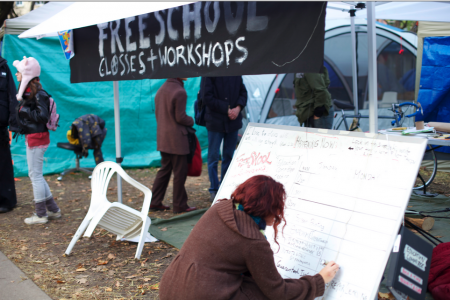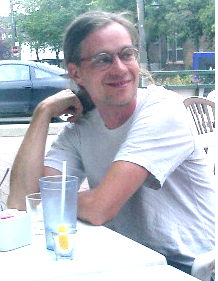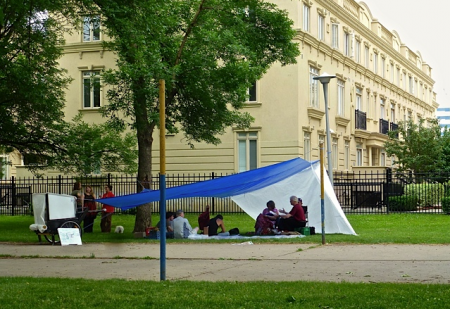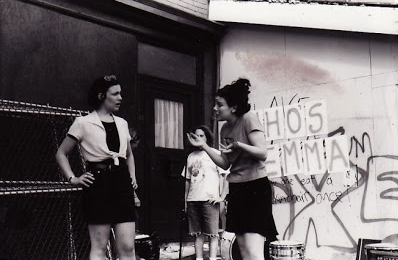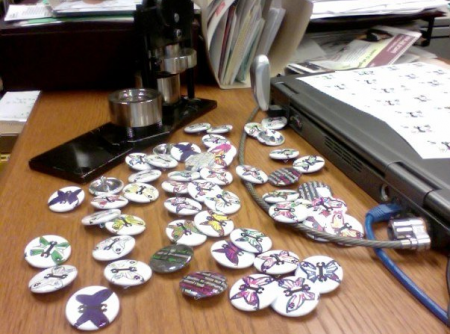Anarchist experiments in education in the Toronto area reflect a history of brief spaces carved out from commercialism, of flowerings of liberation followed by the seeds of the next project to emerge.
Experiments in popular education or free schools have often co-existed with experiments collective living, and have also been tied to particular waves of activism, following Paulo Freire’s theories that liberation education only works when tied to a project of human liberation in general. Anarchist movements in urban areas, like Toronto and nearby cities, thrive in spaces at once marginal and central, and freeschools have emerged along with them.
Some of these projects still live, others have passed on. Anarchist spaces are often temporary, falling slowly to gentrification and eviction, or quickly to police repression. If the free schools that have been created have also been temporary, they are also signposts pointing to the possibility of the future.
Kalin Stacey, connected with some recent freeschool projects in the Toronto, connected the idea of physical space and organizing space: “ One of the things that’s really critical for a freeschool is that it’s both a decentralized and learning project but also a community building project.
He continued: “I would say probably the best scenario for an established freeschool that sticks around is probably to have a radical community centre/social space, autonomous space that also is sustainable and can provide a meeting place, I think that’s something that anarchist free school that happened in the late ‘90s in Kensington had that made it really effective. And when they lost the space they lost the school.”
Kensington Market and the founding of the Anarchist Free University
A tucked-away diverse neighborhood of Toronto, Kensington market had been home back in the 1980s to anarchist-influenced punks who fought legendary battles with neo-nazis, often organizing by word of mouth out of their base in the market. In the 1990s OCAP (Ontario Coalition Against Poverty) fought militant anti-gentrification battles across the city.
Along with this heightened level of political struggle the anarchist scene also flourished in Kensington, with anarchists bookstores and spaces: Who’s Emma, Uprising, and the Anarchist Free Space, where the Anarchist Free School met. The ‘school’ faltered, but was quickly re-born as the Anarchist Free University (AFU), one of the Toronto’s longest-running anarchist projects.
Illogik (half of the the anarchist rap group “Test Their Logik”) was involved in the early 2000s. He says “The AFU was amazingly vibrant when I first got involved, multiple classes each semester, lot of attendance. For me the AFU led to Uprising [bookstore] and then the now defunct collective house which all spawned many different activities. It got me plugged into the community and once in, the vehicle that got me there was less important”.
Maggie, an AFU organizer, noted that freeschool theory needed to be adapted to an urban north American context: “Friere saw peasant and landowners as the crux of power, its defiantly a different thing when its in a society where there’s a more urgent understanding of what’s wrong which I think is sometimes lacking in north America.”
The Decentralized AFU and Possum Man
The AFU, which at one point had shared a house with Bike Pirates (a radical bike collective), eventually became homeless. Poor and working class people in Kensington market and elsewhere began to lose their battles with gentrification, and high rents meant collectives had trouble keeping infoshops or punk venues open. Anarchism went a bit further underground. Without a geographical space or a strong activist movement, the AFU stagnated somewhat along with the dispersed anarchist scene in general.
Although the AFU was decentralized and a bit amorphous, one of the central and persisting figures in this difficult era was a mysterious figure known to everyone as ‘Possum’. Science fiction author and blogger Corey Doctorow called the “ epitome of happy mutanthood”.
A founding member of the AFU, Erik ‘Possum’ Stewart also lived in two important collective houses associated with the free ‘U’. He often preferred to help set up the structure for an fairly open self-regulating system and do the low level maintenance, often in really subtle ways helping consensus work or nudging things along, keeping spaces like the Anarchist U running.
You could have a deep theoretical conversation about any number of topics but never know basic things like what he did for a living. It turned out he’d attended radical high school called SEED and rejected his diploma as a teenager in a statement against formal education. Sadly last summer Possum was found dead by his roommates, an autopsy showed that he’d had a cerebral hemorrhage in his sleep.
Hamilton, the G20 and a new FreeSkool model
New waves of anarchism would arise not out of Toronto itself but from developing scenes in the smaller cities nearby. In Hamilton, an industrial city located an hour south-west of Toronto, a new project was taking off. Peter, one of the founders, told me: “We borrowed the broad concept of FreeSkool but made up all the details on our own”. They invented their own structure, more organized than the AFU, involving a consensus-based collective of 4 committed organizers serving 8-month overlapping terms.
The Hamilton Freeskool also followed Freire’s model of education in connecting courses to praxis, such as the “Radical Practical Solidarity” course that did indigenous solidarity work with the nearby Six Nations on the Grand River. Also in line with his model of teaching skills needed for revolutionary organizing was an emphasis on practical skills like language learning.
Niki Thorne wrote her MA thesis on the project, and writes how burn-out from a three-month militant winter strike at Toronto’s York University in 2008/2009 was transformed into excitement at the community building possibilities at the Hamilton freeskool.
“In contrast to my terrible strike experience” she writes “FreeSkool, for me, has always been this warm welcoming inspiring space, a community of caring and creative people, and an example of the concrete beautiful projects and initiatives that we can build out of our ideas and ideals. To me, FreeSkool represents creativity and community, and is part of building the kind of world we want to live in.”
Toronto anarchists came together with their comrades from other cities during the 2010 G20 protest there, and brought their slightly different freeschool projects with them. An AFU media course created a team who produced a high quality independent film of the mobilization- ‘Tales from the G20’. A freeschool on the Hamilton mode, the Toronto Free School, ran for a year or so in the post-G20 period- but the project “wasn’t successful at planting any roots” says Kalin, and faltered because organizing became increasingly centered on defending those arrested in the actions and prisoner support. (The Hamilton freeskool remained but the AFU also faltered.)
Occupy FreeSchool and beyond
In 2011, when ‘Occupy’ erupted, the continuing popular outrage at police actions during the G20 meant that Toronto had a bit more space from State repression than in other cities. The encampment at St. James Park, with its many trees and rolling hills, and resembled a kind of anachronistic medieval village, but with electrified committee tents, which were joined by three beautiful Yurts.
“Occupy Toronto” collectively decided that it should provide food and tents to all, and became a self-organized community service as well as a protest. Unfortunately, the ‘General Assemblies’, the decision-making bodies for Occupy- were particularly non-functional and were associated with numerous incidents of aggression and violence. In such an environment it was especially important to create an education project that was embedded in the communal living, semi-intentional community that was set of Occupy Toronto.
Kalin, who had been part of the post-G20 freeschool, helped set up the infrastructure along with a few other experienced organizers, ‘Occupy Freeschool’ was set up in such a way that once it was up and running it was somewhat self-sustaining. People simply scheduled classes daily in on a whiteboard leaning on the side of the dedicated tent. Many classes went along with organizing projects at Occupy, such as the recurring class on Anarchist Communism that was attended by many of the people involved in community safety in camp, lending a theoretical basis to the practical work of keeping people as safe and free as possible. Non-anarchists also appreciated the open structure, setting up courses on recycled paper arts, gardening and even Marxism and ‘Zeitgiest’.
The free education framework persisted even once the camp was evicted, although the Occupy community fell apart in exile. Now run by people who learned about freeschools experientially, the “Free’scool” now meets in downtown parks in the summer, creating a temporary physical space and evoking memories of the ‘Occupy’ encampment (classes are currently being held indoors). Roxy, one of the new organizers with the Occupy Free’scool told me: “We desperately need education that is free: for the development of the individual personality - this means education that is culturally relevant, and teaches peace and self-determination.”
Illogik told me: “Occupy built something that crashed against the walls of the state and then receded”, words that apply in general to anarchist organizing and educational projects in Toronto. Organically connected with the anti-authoritarian organizing scenes in Toronto, liberation education has risen and fallen with the tide of militancy in the city. Wresting physical and organization space from capitalism for the projects we need is going to be a difficult,. But its one that has to be done as we move forward. There’s a reason the raccoon (or maybe a possum) is a symbol of urban anarchism - its difficult to live the City but we can survive anyway.
We can’t always fight the system head on, we also have to build the systems that sustain ourselves and our struggles as we move out of the margins to really challenge the system.
Megan Kinch was introduced to anarchism through the Hamilton FreeSkool, and was in involved with the AFU, the Toronto Free School, and Occupy Freeschool. She is currently involved in building people’s media organizations and is an editor with the Toronto Media Co-op.
This article was first published in the magazine "Fifth Estate". This version is slighlty edited from the original print.
